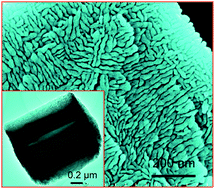Generalized green synthesis and formation mechanism of sponge-like ferrite micro-polyhedra with tunable structure and composition†
Abstract
This paper describes a green versatile glucose-engineered precipitation–sintering process that allows for the selective and mass preparation of spongy porous ferrite (M = Fe, Zn, Co, Ni, Mn, etc.) micro-polyhedra with tunable morphology, texture, and composition. Some kinetic factors, such as the molar ratio of glucose to metal nitrates, reaction temperature, sintering temperature and time, and type of metal nitrates, can be expediently employed to modulate their aspect ratio, shape, size, composition, and textural properties. In this protocol, glucose functions as a reductant, protecting agent, structure-directing agent, and a sacrificial template to guide the assembly of sheet-like nuclei into polyhedral precursors and the formation of spongy porous structures. Owing to larger EM parameters, multiresonant behavior, and dissipative current, spongy porous Fe3O4 polyhedra exhibited enhanced microwave-absorbing properties. This endows them with important potential applications in magnetic devices, catalysis, sorption, photoluminescence, electromagnetic wave absorbing materials, anode materials, and so on. Meanwhile, this general approach can be extended to synthesize other porous sponges with regular geometric configuration because it is simple, inexpensive, environmentally benign, and suitable for extensive production.


 Please wait while we load your content...
Please wait while we load your content...